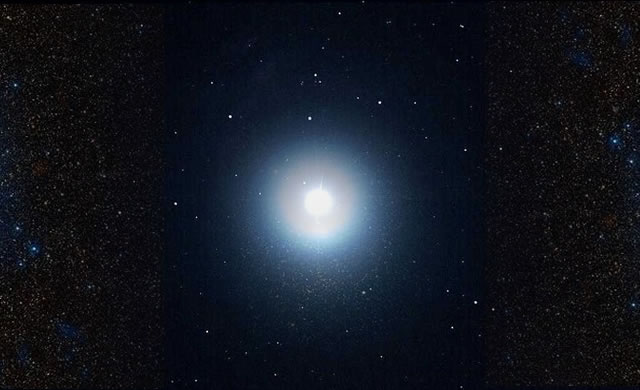
Brillantissima, a soli 25 anni luce dalla Terra, nella costellazione della Lira, Vega è la quinta stella più brillante del cielo notturno.
Nel 1983, gli astronomi scoprirono della polvere in orbita intorno alla stella suggerendo che forse poteva esservi un sistema solare. Fu così che Carl Sagan scelse Vega come fonte di un segnale captato dal SETI nel suo romanzo del 1985 “Contact”, anche se gli alieni mittenti del segnale non erano originari di alcun pianeta orbitante la stessa stella: all’epoca, Vega era ritenuta di un’età pari ad un paio di centinaio di milioni di anni, probabilmente troppo giovane per eventuali pianeti che potessero avere generato la vita. L’ipotetica età di Vega è poi aumentata con il passare del tempo, grazie alle osservazioni degli astronomi che hanno scoperto che la stella girava più velocemente su se stessa, un giro completo ogni 17 ore, e questo fatto significava che era stata sovrastimata la presenza di elementi pesanti e quindi sottostimata la sua età, perchè le stelle massicce evolvono più lentamente. Oggi, gli scienziati della University of Michigan usando l’interferometro CHARA, hanno scoperto che Vega ha circa 2,15 volte la massa del Sole e una età maggiore rispetto a quanto pensato fino ad ora: tra i 625 e gli 850 milioni di anni. L’età quindi di Vega fa dedurre così, che eventuali pianeti orbitanti probabilmente avrebbero avuto il tempo sufficiente per sviluppare una forma di vita primitiva. La ricerca è stata pubblicata su “The Astrophysical Journal Letters”.
Shining just 25 light-years from Earth in the constellation Lyra, Vega (false-color infrared image shown) is the fifth brightest star in the night sky.
In 1983, astronomers discovered dust orbiting the star, suggesting it had a solar system, and Carl Sagan (pictured) chose to make Vega the source of a SETI signal in his 1985 novel Contact, though the responsible aliens weren’t native to the star: At the time, Vega was thought to be only about a couple hundred million years old, probably too young for any planets to have spawned life. Since then, however, estimates of Vega’s age have increased, because astronomers learned that the star spins fast—once every 17 hours—which stirs up the star’s interior and forces the surface composition to match the overall composition of the star. This discovery meant that scientists had been overestimating the star’s abundance of heavy elements, which in turn meant they had been overestimating its mass—and thus underestimating its age, because less massive stars evolve more slowly. Now, scientists have studied Vega with the CHARA interferometer, an array of telescopes in California yielding crisp views of stars, and modeled the observations by using new computations of how fast-spinning stars age. As the researchers will report in The Astrophysical Journal Letters, Vega is 2.15 times as massive as the sun—agreeing with work from recent years—but considerably more mature than had been previously thought. The star is between 625 million and 850 million years old, so suitable planets have probably had sufficient time to develop primitive life.
Source/Continue reading → news.sciencemag.org
Related posts – Potrebbe interessarti leggere anche: First Contact: are you ready for it? (VIDEO – “Contact”)


















Pingback: Il Sistema stellare di Vega e Fomalhaut sembra ospitare diversi pianeti – Alien Asteroid Belt Discovery Hints at Hidden Planets | DENEB Official ©